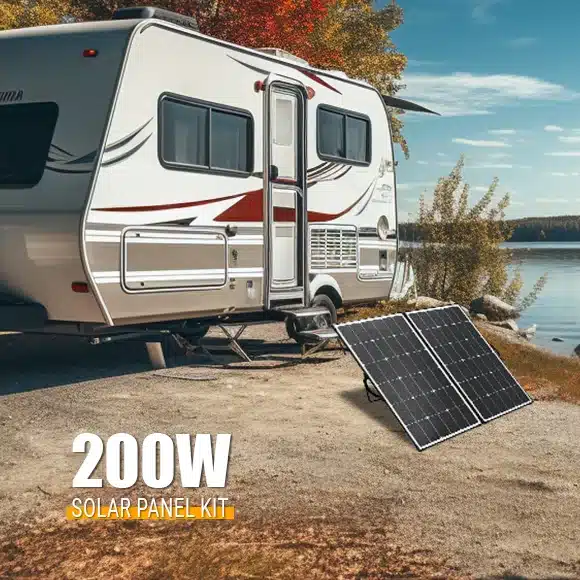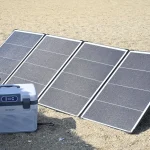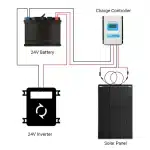Have you ever come across the term ‘Amp’ and wondered what ‘amp’ is or how it relates to other units like watts? Ampere is the unit for measuring constant electric current. Understanding amperes will help you design safe electrical systems and choose the ideal power supply for charging all your household or outdoor appliances.
In this guide, we will introduce the basic definition of ampere and how it differs from units like watt, volt, and ohm.”
What does amp mean
Before delving into the calculation of amperes, let’s first understand some basics – what is an Amp?
An Amp (A) is abbreviated as Amp and is one of the standard units of measurement used to define power or current. Here, current refers to the speed or rate at which electrons flow through a conductor. You can think of current as the flow of water through a hose, where amplifiers act like the water.
But what exactly is an Amp-hour (Ah)? An ampere-hour is defined as one ampere of current flowing for one hour. When it comes to battery capacity, ampere-hours or ampere-hour ratings determine how much current a battery can provide in one hour. Higher amperes result in faster charging of devices. Amperes represent the intensity of the current and are measured in watts.
When supplying power to electronic devices or investing in portable solar panels, it’s essential to consider battery capacity in amperes. This is because the battery’s capacity directly affects how quickly it can charge your devices. Matching portable solar panels with portable storage should also be taken into account for charging and storing purposes.
Amp vs. Volt, Ohm, and Watt
Amp, Volt, Watt, and Ohm are four fundamental concepts you’ll encounter when dealing with electrical systems.
Just understanding what an amplifier is won’t suffice; you also need to understand what amperes, volts, and ohms are. These three play crucial roles in electrical systems.
1. Volt (V): A measure of the electric potential or “pressure” when current flows through a system. Voltage is also described as the speed at which a single electron moves through a circuit, measured in volts. In some regions, electrical power is delivered to homes at two different voltages or “pressures”: 120 volts and 240 volts.
2. Watt (W): The rate at which electrical energy is transmitted in a circuit is called wattage or watts (W)(Volts to Watts Conversion). To calculate watts, you simply multiply voltage (pressure/speed) by amperage (volume), expressed as V x A = W.
3. Ohm (Ω): Denoted by the symbol Ω, this unit measures resistance within a conductor. It slows down the flow of electrons through the circuit.
Remember that all these electrical terms are interconnected, and you can easily convert volts to watts or amperes to volts using simple formulas:
Formulas:
– Watt = Volt × Amp(W = V × A)
– Volt = Amp × Ohm (V = I × R)
– Amp = Watt / Volt (A = W / V)
In electrical systems, adding current or voltage results in higher power. For instance, if you have a 6-volt light bulb connected to a 6-volt battery with an output power of 100 watts, you can calculate how many amperes of current it needs to produce 100 watts of power using the equation I = P/V:
I = 100 W / 6 V = 16.67 amperes
What happens if you use a 12-volt battery and a 12-volt light bulb to achieve 100 watts of power?
I = 100 W / 12 V = 8.33 amperes
In this case, the same power is produced, but the current is only half. Using less current to produce the same power has an advantage. Resistance in the wires consumes power, and the power consumed increases with the increase in current flowing through the wires. By slightly rearranging the two equations, you can see how this happens. What you need is the power equation expressed with resistance and current. Let’s rearrange the first equation:
I = V/R can be rewritten as V = I * R
Now you can substitute the V equation into the other equation:
P = V * I, replacing V, we get P = I * R * I, or P = I^2 * R
This equation tells you that if the resistance of the wire increases (e.g., if the wire becomes smaller or is made of a less conductive material), the wire will consume more power. But if the current through the wire increases, it will increase significantly. Therefore, using higher voltage to reduce current can make electrical systems more efficient. The power of electric motors also improves at higher voltages.
How to Measure Amp?
An ammeter is a device used to measure the amount of current flowing through a component. When in use, the ammeter must be connected in series with the component, meaning it is connected one after the other in the circuit.
By measuring current, the ammeter can accurately display the electrical activity within the circuit, helping you understand how much electrical charge the equipment is consuming.
There are two types of ammeters:
1. Shunt Ammeters
2. Hall Effect Sensors
Ammeters are essential when designing, constructing, or troubleshooting electrical circuits. This device can help you understand the amount of current flowing through various cables when working on wiring projects or diagnosing faults in electrical systems. Additionally, you can use this device to measure the amperage flowing in and out of indoor batteries over a period of time. This information can be valuable in determining how long it takes for the battery to charge or power devices.
What is the relationship between all these terms and solar energy?
Understanding the terms and formulas mentioned above is crucial because they help in calculating the capacity and output of solar power generation systems, whether they are off-grid or grid-tied systems.
There is also a formula for power. In this formula, P represents power in watts, I represents current in amperes, and V represents the potential difference (or voltage) across the component in volts.
Many times, this is also expressed as W = V * A, which means watts are equal to volts multiplied by amperes. Let’s rearrange this formula as an example:
W = V * A
V = W / A
A = W / V
This example will clarify why higher direct current (DC) voltage is preferred in large solar power systems.
Suppose you have a load of 1000 watts to operate. This equates to:
– 12 volts at 83.3 amperes
– 24 volts at 41.6 amperes
– 48 volts at 20.8 amperes
– 120 volts at 8.3 amperes
– 240 volts at 4.1 amperes
Understanding the current flowing to the load is crucial for selecting the right wiring. We consider voltage drop over distance. Ideally, we don’t want the voltage drop to exceed 3%. The other half of this calculation is the current. You need larger wires to carry more current. If possible, higher voltage is better.
These formulas can also be used to calculate the wattage of appliances (loads) to confirm the size of the inverter. The inverter converts the direct current generated by the solar panel array into alternating current (AC) for powering lights and appliances in homes and businesses. Electrical appliances typically have a label with their electrical specifications. For example, if a microwave has a rated current of 8.3 amperes on its label, typically found on the back of the oven, to calculate wattage, you can multiply 8.3 amperes by the household voltage, say 120 volts. This equals 996 watts.
Now, let’s calculate how much electricity the microwave consumes in a day. If you use the microwave for 2 hours every day, you can calculate the watt-hours per day by multiplying the hours used by the wattage. So, your electricity consumption would be 996 watts multiplied by 2 hours, which equals 1992 watt-hours per day.
This formula is useful in determining the total power consumption per day when sizing a solar power generation system.
Watt = Amp x Volt
Volt = Watt / Amp
Amp = Watt / Volt
Applied in practical cases with solar panels?
We have learned some basic electrical circuit knowledge, such as Ohm’s law (which is voltage = current * resistance), and formulas for calculating power:
1. Current (A) × Voltage (V) = Power (W)
2. Current × Duration of Use = Battery Capacity in Ampere-hours (Ah)
Simply put, 1 Ah means discharging 1 amp for 1 hour.
With this background knowledge, we also need to know some conditions:
1. Load power and voltage.
2. Daily working hours.
3. Location of use (installation).
4. Sunlight hours.

Example 1: Given a battery voltage of 12V and a capacity of 200Ah, what size of solar panel is needed to fully charge the battery in two days? (Average daily effective sunlight is 4 hours)
Calculation:
(1) The energy stored in the battery is 12V * 200Ah = 2400Wh
2400Wh / 4 hours = 600W
600W / 2 days = 300W
Therefore, a 300W solar panel with 18V is needed.
Example 2: A 100W solar panel generates electricity for how many hours for 40W/12V LED lights in one day? Assuming the LED lights work for 8 hours a day and need to work continuously for 3 days during rainy weather. What size of the battery is needed? (Location: Italy, sunlight hours assumed to be 4 hours)
Calculation:
(1) Daily electricity generated by the solar panel is: 100W * 4 hours = 400Wh
Given LED light power is 40W
400Wh / 40W = 10 hours
So, it can power LED lights for 10 hours.
(2) Since the LED lights work 8 hours a day, the daily electricity consumption is 40W * 8 hours = 320Wh
Consumption over 3 days is 3 days * 320Wh = 960Wh
960Wh / 12V = 80Ah
However, you should choose a battery with a 20% margin.
80Ah * 1.2 = 96Ah
So, you should choose a 12V 96Ah battery.
Example 3: If the required load demand is 48W/12V, and it operates for 10 hours a day, how should the solar power system be configured to ensure the load operates normally even on three consecutive cloudy days? (Location: Germany, standard sunlight hours assumed to be 4 hours)
Calculation:
(1) Calculate the solar photovoltaic panel power:
The daily electricity consumption of the load is: 48W * 10 hours = 480Wh
480Wh / 4 hours = 120W
(18V solar panels charge 12V batteries, 36V solar panels charge 24V batteries)
Since the solar panel not only supplies the load but also charges the battery, the solar panel chosen should be greater than 120W.
(2) Calculate the battery capacity:
The electricity consumed by the load over three days is 480Wh * 3 days = 1440Wh
1440Wh / 12V = 120Ah
However, a battery should be chosen with a 20% margin.
So, the battery capacity is 120Ah * 1.2 = 144Ah.
Therefore, the system configuration should be:
– Solar panel voltage: 18V
– Solar panel power: 120W or higher
– Battery: 12V 144Ah
What Are Common Questions and Answers About An Amp?
Now that you have a basic understanding of “What is an ampere” and how to measure it, here are some common questions.
1. Are AC amperes the same as DC amp?
AC and DC are two types of electric currents that flow through circuits. However, they are different. Direct current (DC) flows in one direction while alternating current (AC) changes its direction multiple times per second.
2. How can I safely use a home electrical system?
Here are some safety precautions for operating a home electrical system:
– Turn off the power before working. Use circuit breaker locks or labels on the distribution panel to prevent accidental power-on.
– Before turning off the power, ensure that your multimeter or electrical tester is functioning correctly.
– When working with live electrical components, wear non-conductive gloves, safety glasses, and sturdy footwear.
Learn more about it:
Electricity Uncovered: Volts to Watts Conversion
What does ‘Ah’ on a battery mean?
What Is mAh: A Beginner’s Guide
Explanation of Watts vs Watt hours, Amp hours vs Watt hours








